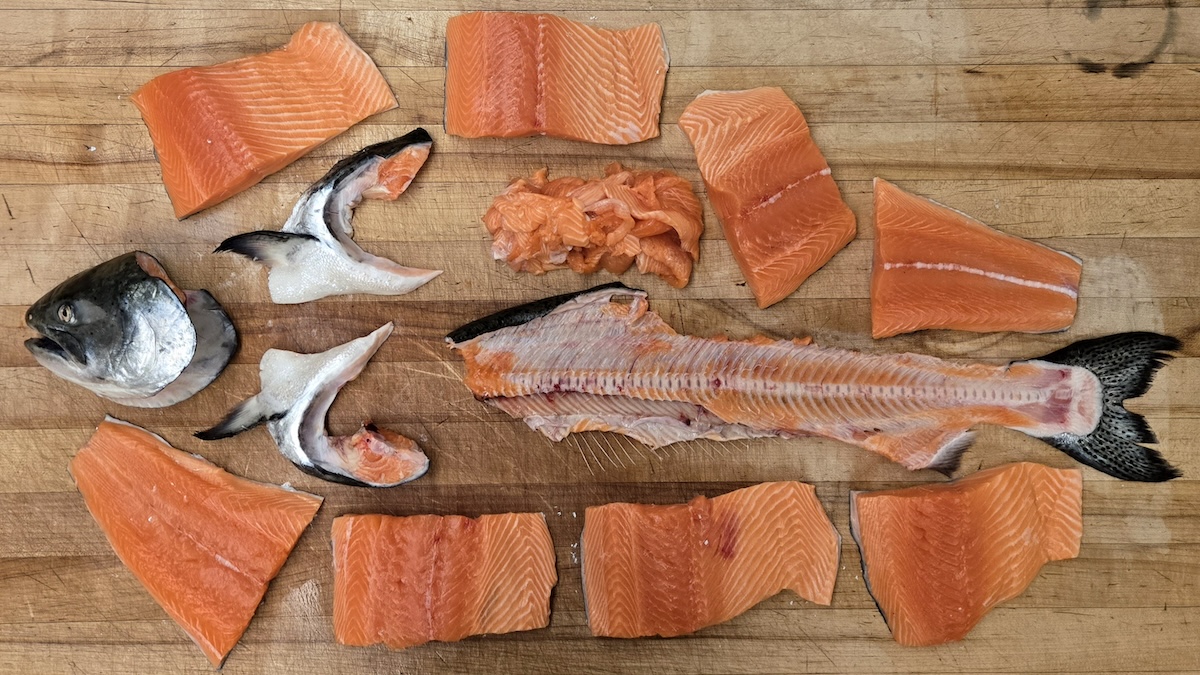A bucket of stripped salmon carcasses, leaning against the stern of the boat, obstructed my daily deck-scrubbing duties. As my skipper counted the post-trip tip money, he gave the bucket a casual nod and said, “Feel free to take those collars home for dinner if you want.”
“Uh… what’s a collar?” I asked, my curiosity outweighed by my cluelessness.
With a grin, he grabbed a knife, reached into the bucket, and pulled out a mangled king salmon by the tail. With two swift, practiced cuts—one behind the head and the other at the fillet line—he revealed a chunk of fish that looked surprisingly appetizing. “There you go,” he said, handing me my first fish collar. “The best cut nobody notices.”
Brined and smoked, these king collars became my go-to snack on the water.
The Chicken Wing of the Sea
Fish can be broken down further than just two fillets, and similar to game animals, not all cuts are created equal. The top loin of a fish is generally much leaner than its belly. Hence, the premium on salmon and tuna bellies at the fish market. Cheek meat has a totally different structure than the flaky fillets we all know, which is why halibut cheeks are so sought after.
Each part of a fish has pros and cons; the differences will dictate the cooking or non-cooking (raw) approaches we take in the kitchen. For instance, fattier cuts lend themselves well to slow cooking and raw preparations, while leaner cuts tend to do better with a quick sear.
That brings us to the collar—an often discarded cut of fish that shouldn’t be. Specifically, the collar refers to the meat around the collarbone and the tender flesh connected to the pectoral fin after filleting. The collarbone provides structure to the cut, while its higher fat content ensures it stays moist. Once cooked, the tender meat easily falls off the bone!
How to Remove the Collar
Start by filleting the fish like you normally would. When both fillets are removed, you will have a head, a stripped spine, and a collar.
To begin, sever the spine where you made your initial diagonal fillet cut, leaving the head and collar intact. Next, cut the membrane behind the last gill toward the tail.
The head should now only be attached by the spine, cut through it to decapitate the fish. Finally, wipe off any blood or slime and trim away any gill still attached to the collar.
You can leave the two collars connected by the spine or split them in half. For standalone collar dishes, cut your initial fillet towards the tail to preserve more meat around the pectoral fin and upper loin.

How Fish Collars are Cooked Around the World
In Southeast Asia, fish collars are a prized addition to stews and soups, valued for their rich flavor and tender texture. The collagen and fat slowly break down as they simmer, infusing the broth with umami. The meat, nestled around the bone, becomes incredibly tender, flaking effortlessly into the dish. This cooking method enhances flavor and maximizes the use of an often-overlooked cut, making it a nutrient-dense approach in the kitchen.
In Central America, collars are thrown into tomato-based sauces and simmered until they flake off the bone. The meat is then thrown into tacos, resulting in bite-sized pieces of fish that are anything but dry.
As you would expect, collars are breaded and fried in Louisiana. The fins crisp up, and the meat remains tender.
On the other hand, the Japanese take a simple approach to let the cut shine on its own. After a light marinade, the collars are cooked over high heat using a specialized charcoal grill called a Shichirin. Salmon and tuna are their preferred species due to their high-fat content.
In Alaska, salmon collars are saved for the smoker. Their rich, oily texture soaks up the smoky flavor after a simple brine of salt and sugar. Once smoked, they become the perfect on-the-go snack, lacking the need for refrigeration for short periods of time.
Don’t Let the Best Bite Go to Waste
With so many ways to prepare fish collars, there’s no reason to let them go discarded. Whether grilled, smoked, stewed, or fried, this hidden gem offers some of the fish’s most flavorful, tender meat. I still cringe at all the collars I ignorantly sacrificed to the sharks and ‘cudas—and I certainly don’t make that mistake anymore.
Read the full article here

